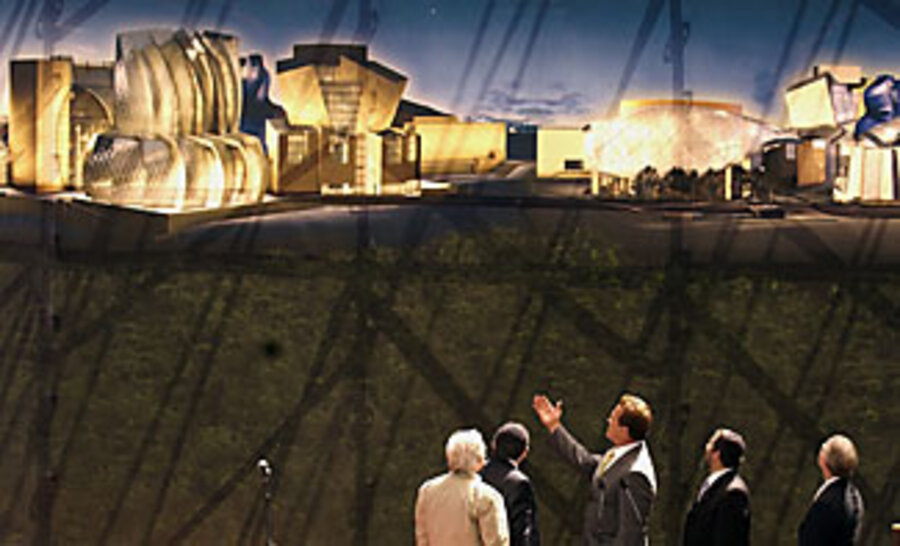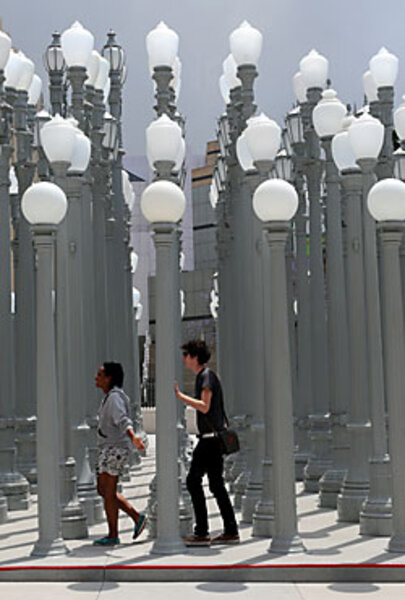Museums' new mantra: Connect with community
Loading...
| Los Angeles
From San Francisco to Jerusalem, museums are bustling with new construction – and new visions, strategic plans, and ambitious initiatives, not to mention visitors. This attendance surge is fueled somewhat by the attractively low entrance fees in these tough times.
But the boom in reinvention is powered in larger part by a profound and permanent change going on between museums and their constituents, say directors, educators, and curators. The graying of the traditional museum patron, the shifting global demographic mix, and the new cultural consumption habits of a younger generation are forcing most museums to make fundamental and not always comfortable changes – refashioning themselves from bastions of remote culture into social centers and community hubs.
"It's not about the collections anymore," says strategist James Chung of ReachAdvisors, who consults for cultural institutions around the globe. "It's about community."
Whether it is the impending, state-of-the-art Museum of Tolerance rising in Jerusalem (geared toward unifying a fractured city) or a new museum in the heart of strife-racked Colombia (aimed at helping the town of Medellín heal after years of narco-warfare), community relevance is the new museum mantra.
"We did not want to be just static artifacts from the past," says Rabbi Marvin Hier, dean of the Simon Wiesenthal Center behind the Israeli project, which will feature participatory, constantly updating exhibits, as well as a conference center where the community can gather to address current issues. "Museums must deal with yesterday, but today and tomorrow as well."
With the rise of powerful social-network tools on the Internet and a generation weaned on collective participation and decisionmaking, institutions must adapt or die, says Emlyn Koster, president of New Jersey's Liberty Science Center, which just completed a $109 million renovation to increase its communitywide value.
"This generation is about social relevance and global connection," says Mr. Koster, who calls this the third stage in modern museum evolution, following the 19th-century model of the curio cabinet guarded by experts, which gave way to an emphasis on interactivity in the 1960s.
Few museums have the luxury of a total shutdown to reorient, points out Elizabeth Merritt, director of the newly created Center for the Future of the Museum at the American Association of Museums in Washington. The center was founded as a think tank for the roughly 17,500 museums in the United States (only 3,000 of which are members of the AAM). It grew out of the group's centennial celebration in 2006 at which "we realized the pace of change has accelerated much more rapidly than most museums are able to adapt." The message, she says, is that museums must think holistically, with attention to social, political, and environmental factors.
Museums worldwide have taken a page from this new operating manual. Amgueddfa Cymru National Museum of Wales is part of Stories of the World (SOTW) – a major project for the London 2012 Cultural Olympiad. This unites 59 museums, libraries, and archives across the United Kingdom to create more than 35 exhibitions for 2011-12 that will reconnect museum collections with the people and communities from which they came. The SOTW project in Wales, "Bling," which examines the history of precious metals, draws on disadvantaged youths from all over the region to take the lead in creating the show. They will create connections between artifacts around the world and modern fashions.
While community disengagement affects the small or mid-size museum more immediately, even singular, encyclopedic destinations such as New York's Metropolitan Museum of Art are not immune, says director Thomas Campbell. Noting the problems inherent in making a collection of well over 2 million objects in some 20 databases accessible and engaging to every type of visitor, Mr. Campbell says the Met has just launched a two-year initiative to redesign its website to, among other things, allow users to "tag" and create dialogues around individual pieces in the museum. "We're working hard to appeal not just to the sophisticated museum visitor, but the beginner as well," he adds.
Engaged participation, the key to developing community, is a lesson that is now tumbling from the education wings of many museums into mainstream curatorial practices, says Los Angeles County Museum of Art (LACMA) curator Charlotte Cotton. "Our education wings have always known the importance of hands-on learning because they deal with schoolchildren," says Ms. Cotton, but now "the larger museum world is seeing that we're all dealing with education with a soft 'e.' "
The new LACMA mandate is to be seen as a "town center," she says, a locale in which every segment of the city's population plays a part. She points to last November's Machine Project event as a tipping point in the museum's journey to a new relationship with the town. It was a day-long "art happening," in which artists traipsed through galleries filled with more than 5,000 visitors, inventing as they progressed.
"There were a lot of concerns from people within the museum about vandalism and damage, but it turned out wonderfully, and nothing was hurt," Cotton says. She actively seeks ways to incorporate community input as part of the curatorial message of a show. This past year, she oversaw "Urban Light," a permanent installation of 202 vintage streetlamps along the museum's facade. Angelenos began photographing the lamps, and soon LACMA realized it had an event on its hands and organized an online competition. The best photos subsequently were compiled into a print-on-demand book, still available online.
Cotton's next show pushes the vision of shared curatorial input even further. "Eat LACMA," which launches next spring, will invite groups citywide to create food diaries to be used to create an art event drawing on food themes in the museum's collections. "Eat" will culminate with a harvest festival in October.
When the Oakland Museum of California reopens in 2010 after a $56 million renovation, it will feature many participatory elements such as interactive journals, in which visitors can converse with each other and the museum curators. In an early demonstration, museum education curator Barbara Henry says these journals were "wildly popular." The team drew on lessons from an earlier show, "Cool Remixed," which tapped local at-risk youth to create exhibits based on their own experiences. Ms. Henry points out that reaching out to nontraditional audiences is vital. "If we don't cultivate these connections, we will be a dying institution of older white people," she says, noting that soon the US will be a country of majority minority populations.
As budgets have tightened throughout the ranks, museums are looking to maximize their resources, says New York Institute of Technology professor Stan Silverman. He works with museums from the Met to the smallest local institutions to give them the latest tools, such as Elluminate VCS, a new desktop videoconferencing program that allows real-time field trips for schools for not much more than the price of a USB cord. "If we can't help the next generation tap into the kind of deep learning that they need, we will lose them," he says.
Even within museum walls, technology is "teaching," enabling crowds to make connections for themselves. In Nicole Cohen's "Please Be Seated," a recent exhibit at the Getty Center in Los Angeles, the artist placed white chairs in a room with monitors. Commissioned by the Getty to expand understanding of its antique furniture collections, software "placed" visitors who sat in the chairs among digital recreations of the historical milieus in which the ornate furniture collection would have existed. People could sit in the chairs and watch themselves on screen.
"It's empowering," says Ms. Cohen, by phone from Germany where she is based, "because the real chairs are too fragile to touch, but this way people can feel and see themselves in these exotic worlds where the furniture actually functioned."
Across the country, Pittsburgh's Carnegie Museum of Natural History is in the midst of a long-range strategic plan. Director Samuel Taylor says this generation will not get involved if it can't participate. "One of our most important recommendations will include inviting local graduate students to plan exhibitions and contribute to the curatorial process," he adds.
In one of the most extreme examples, the 40-year-old Fuller Art Museum in Brockton, Mass., closed and then, phoenixlike, reappeared as the Fuller Craft Museum, now one of the premier craft museums in the nation based on collections with established connections to a constituency. Roger Sametz, of Sametz Blackstone Associates, a marketing firm, advised on the transformation. People want a personal, relevant connection, he says, whether through technology such as Twitter or Facebook or physical participation. "It's all about making personal, meaningful connections with a community, now."






